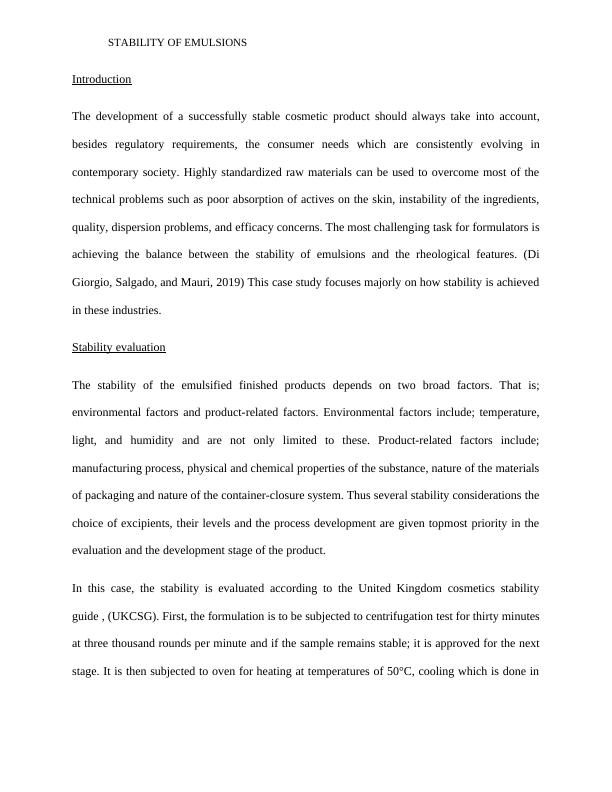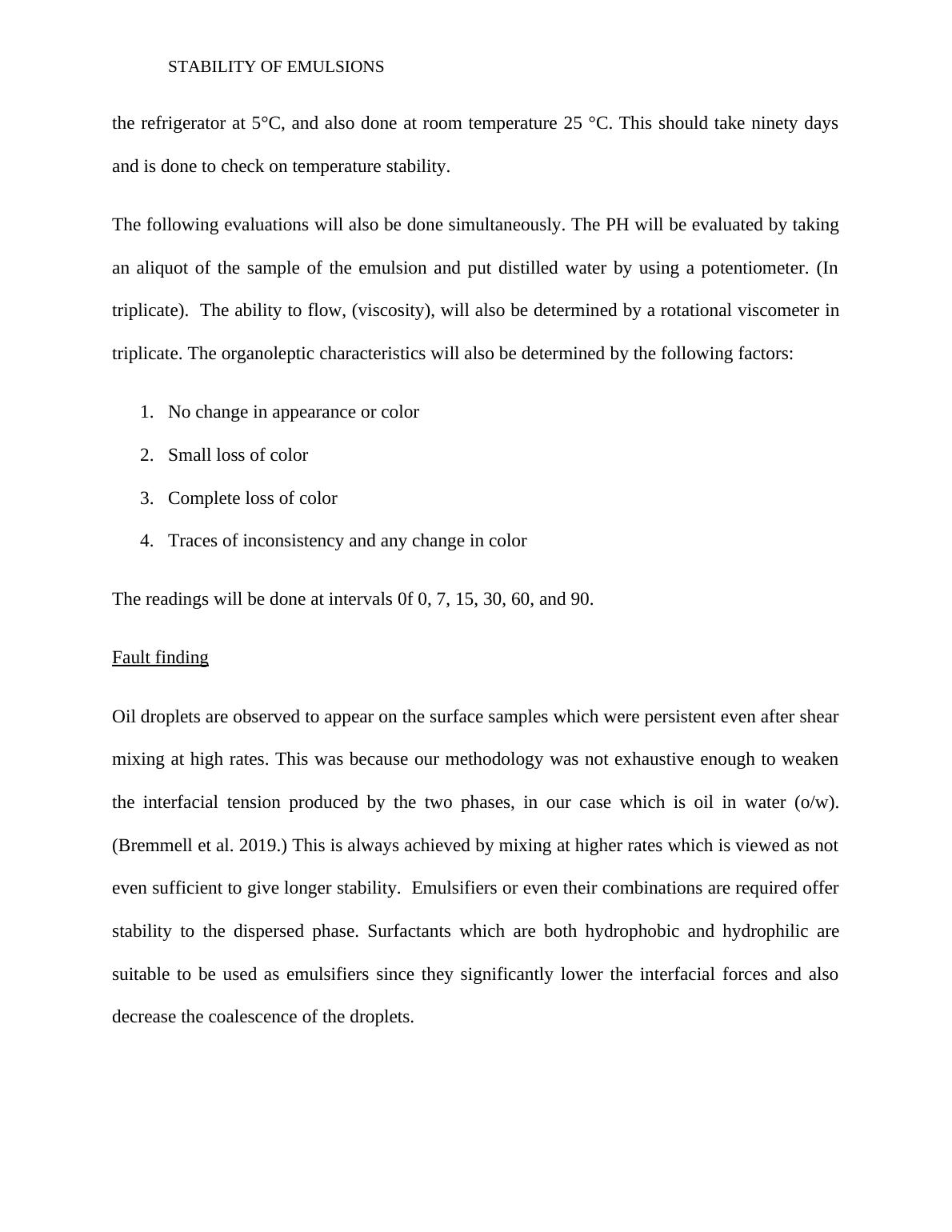Stability of Emulsions - Cosmetic Industries
Added on 2022-08-21
10 Pages1956 Words14 Views
STABILITY OF EMULSIONS
Stability of Emulsions
Students Name
Institutional Affiliations
Stability of Emulsions
Students Name
Institutional Affiliations

STABILITY OF EMULSIONS
Introduction
The development of a successfully stable cosmetic product should always take into account,
besides regulatory requirements, the consumer needs which are consistently evolving in
contemporary society. Highly standardized raw materials can be used to overcome most of the
technical problems such as poor absorption of actives on the skin, instability of the ingredients,
quality, dispersion problems, and efficacy concerns. The most challenging task for formulators is
achieving the balance between the stability of emulsions and the rheological features. (Di
Giorgio, Salgado, and Mauri, 2019) This case study focuses majorly on how stability is achieved
in these industries.
Stability evaluation
The stability of the emulsified finished products depends on two broad factors. That is;
environmental factors and product-related factors. Environmental factors include; temperature,
light, and humidity and are not only limited to these. Product-related factors include;
manufacturing process, physical and chemical properties of the substance, nature of the materials
of packaging and nature of the container-closure system. Thus several stability considerations the
choice of excipients, their levels and the process development are given topmost priority in the
evaluation and the development stage of the product.
In this case, the stability is evaluated according to the United Kingdom cosmetics stability
guide , (UKCSG). First, the formulation is to be subjected to centrifugation test for thirty minutes
at three thousand rounds per minute and if the sample remains stable; it is approved for the next
stage. It is then subjected to oven for heating at temperatures of 50°C, cooling which is done in
Introduction
The development of a successfully stable cosmetic product should always take into account,
besides regulatory requirements, the consumer needs which are consistently evolving in
contemporary society. Highly standardized raw materials can be used to overcome most of the
technical problems such as poor absorption of actives on the skin, instability of the ingredients,
quality, dispersion problems, and efficacy concerns. The most challenging task for formulators is
achieving the balance between the stability of emulsions and the rheological features. (Di
Giorgio, Salgado, and Mauri, 2019) This case study focuses majorly on how stability is achieved
in these industries.
Stability evaluation
The stability of the emulsified finished products depends on two broad factors. That is;
environmental factors and product-related factors. Environmental factors include; temperature,
light, and humidity and are not only limited to these. Product-related factors include;
manufacturing process, physical and chemical properties of the substance, nature of the materials
of packaging and nature of the container-closure system. Thus several stability considerations the
choice of excipients, their levels and the process development are given topmost priority in the
evaluation and the development stage of the product.
In this case, the stability is evaluated according to the United Kingdom cosmetics stability
guide , (UKCSG). First, the formulation is to be subjected to centrifugation test for thirty minutes
at three thousand rounds per minute and if the sample remains stable; it is approved for the next
stage. It is then subjected to oven for heating at temperatures of 50°C, cooling which is done in

STABILITY OF EMULSIONS
the refrigerator at 5°C, and also done at room temperature 25 °C. This should take ninety days
and is done to check on temperature stability.
The following evaluations will also be done simultaneously. The PH will be evaluated by taking
an aliquot of the sample of the emulsion and put distilled water by using a potentiometer. (In
triplicate). The ability to flow, (viscosity), will also be determined by a rotational viscometer in
triplicate. The organoleptic characteristics will also be determined by the following factors:
1. No change in appearance or color
2. Small loss of color
3. Complete loss of color
4. Traces of inconsistency and any change in color
The readings will be done at intervals 0f 0, 7, 15, 30, 60, and 90.
Fault finding
Oil droplets are observed to appear on the surface samples which were persistent even after shear
mixing at high rates. This was because our methodology was not exhaustive enough to weaken
the interfacial tension produced by the two phases, in our case which is oil in water (o/w).
(Bremmell et al. 2019.) This is always achieved by mixing at higher rates which is viewed as not
even sufficient to give longer stability. Emulsifiers or even their combinations are required offer
stability to the dispersed phase. Surfactants which are both hydrophobic and hydrophilic are
suitable to be used as emulsifiers since they significantly lower the interfacial forces and also
decrease the coalescence of the droplets.
the refrigerator at 5°C, and also done at room temperature 25 °C. This should take ninety days
and is done to check on temperature stability.
The following evaluations will also be done simultaneously. The PH will be evaluated by taking
an aliquot of the sample of the emulsion and put distilled water by using a potentiometer. (In
triplicate). The ability to flow, (viscosity), will also be determined by a rotational viscometer in
triplicate. The organoleptic characteristics will also be determined by the following factors:
1. No change in appearance or color
2. Small loss of color
3. Complete loss of color
4. Traces of inconsistency and any change in color
The readings will be done at intervals 0f 0, 7, 15, 30, 60, and 90.
Fault finding
Oil droplets are observed to appear on the surface samples which were persistent even after shear
mixing at high rates. This was because our methodology was not exhaustive enough to weaken
the interfacial tension produced by the two phases, in our case which is oil in water (o/w).
(Bremmell et al. 2019.) This is always achieved by mixing at higher rates which is viewed as not
even sufficient to give longer stability. Emulsifiers or even their combinations are required offer
stability to the dispersed phase. Surfactants which are both hydrophobic and hydrophilic are
suitable to be used as emulsifiers since they significantly lower the interfacial forces and also
decrease the coalescence of the droplets.

End of preview
Want to access all the pages? Upload your documents or become a member.
Related Documents
High Internal Phase Emulsion (HIPE): Assignmentlg...
|3
|2080
|434
Water/Oil separation using PolyHIPE as demulsifier absorberlg...
|1
|315
|159
